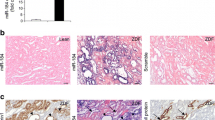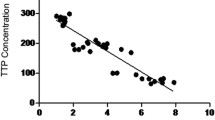Abstract
Aims/hypothesis
The contribution of aberrantly expressed microRNAs (miRNAs) to diabetic nephropathy in vivo is poorly understood.
Methods
Integrated comparative miRNA array profiling was used to examine the expression of serum miRNAs in patients with diabetic nephropathy. The abundance of miRNA-135a (miR-135a) was measured by real-time quantitative PCR in the serum and kidney tissues of patients with diabetic nephropathy. The luciferase assay combined with mutation and immunoblotting was used to screen and verify the bioinformatically predicted miRNAs. Ca2+ entry or intracellular Ca2+ ([Ca2+]i) was performed by imaging Fura-2/AM-loaded cells using a fluorescence microscopy system. The role of miR-135a in vivo was explored with locked nucleic acid antisense oligonucleotides.
Results
MiR-135a was markedly upregulated in serum and renal tissue from patients with diabetic nephropathy, as well from db/db mice, and this was associated with the development of microalbuminuria and renal fibrosis. Furthermore, we identified transient receptor potential cation channel, subfamily C, member 1 (TRPC1) as a target of miR-135a during renal injury. We demonstrated that overexpression of TRPC1 was able to reverse the pathological effects of miR-135a on promoting proliferation of mesangial cells and increasing synthesis of extracellular matrix proteins. Moreover, miR-135a attenuated store depletion-induced Ca2+ entry into cells by regulating TRPC1. Importantly, knockdown of miR-135a in diabetic kidneys restored levels of TRPC1 and reduced synthesis of fibronectin and collagen I in vivo. Suppressing TRPC1 levels to prevent Ca2+ entry into cells may be a mechanism whereby miR-135a promotes renal fibrosis in diabetic kidney injury.
Conclusions/interpretation
These findings suggest an important role for miR-135a in renal fibrosis and inhibition of miR-135a might be an effective therapy for diabetic nephropathy.






Similar content being viewed by others
Abbreviations
- ECM:
-
Extracellular matrix
- HMC:
-
Human mesangial cell line
- LNA:
-
Locked nucleic acid
- miRNAs:
-
MicroRNAs
- PCNA:
-
Proliferating cell nuclear antigen
- SOCs:
-
Store-operated channels
- TRPC1:
-
Transient receptor potential cation channel, subfamily C, member 1
References
Zhong X, Chung AC, Chen HY et al (2013) miR-21 is a key therapeutic target for renal injury in a mouse model of type 2 diabetes. Diabetologia 56:663–674
He F, Xia X, Wu XF, Yu XQ, Huang FX (2013) Diabetic retinopathy in predicting diabetic nephropathy in patients with type 2 diabetes and renal disease: a meta-analysis. Diabetologia 56:457–466
Kanwar YS, Sun L, Xie P, Liu FY, Chen S (2011) A glimpse of various pathogenetic mechanisms of diabetic nephropathy. Annu Rev Pathol 6:395–423
Kato M, Putta S, Wang M et al (2009) TGF-beta activates Akt kinase through a microRNA-dependent amplifying circuit targeting PTEN. Nat Cell Biol 11:881–889
Putta S, Lanting L, Sun G, Lawson G, Kato M, Natarajan R (2012) Inhibiting microRNA-192 ameliorates renal fibrosis in diabetic nephropathy. J Am Soc Nephrol 23:458–469
Long J, Wang Y, Wang W, Chang BH, Danesh FR (2011) MicroRNA-29c is a signature microRNA under high glucose conditions that targets Sprouty homolog 1, and its in vivo knockdown prevents progression of diabetic nephropathy. J Biol Chem 286:11837–11848
He L, Hannon GJ (2004) MicroRNAs: small RNAs with a big role in gene regulation. Nat Rev Genet 5:522–531
Chin LJ, Slack FJ (2008) A truth serum for cancer—microRNAs have major potential as cancer biomarkers. Cell Res 18:983–984
Mitchell PS, Parkin RK, Kroh EM et al (2008) Circulating microRNAs as stable blood-based markers for cancer detection. Proc Natl Acad Sci U S A 105:10513–10518
Ng EK, Chong WW, Jin H et al (2009) Differential expression of microRNAs in plasma of patients with colorectal cancer: a potential marker for colorectal cancer screening. Gut 58:1375–1381
Liu S, Guo W, Shi J et al (2012) MicroRNA-135a contributes to the development of portal vein tumor thrombus by promoting metastasis in hepatocellular carcinoma. J Hepatol 56:389–396
Zhou W, Li X, Liu F et al (2012) MiR-135a promotes growth and invasion of colorectal cancer via metastasis suppressor 1 in vitro. Acta Biochim Biophys Sin (Shanghai) 44:838–846
Chen Y, Zhang J, Wang H et al (2012) miRNA-135a promotes breast cancer cell migration and invasion by targeting HOXA10. BMC Cancer 12:111
Agarwal P, Srivastava R, Srivastava AK, Ali S, Datta M (2013) miR-135a targets IRS2 and regulates insulin signaling and glucose uptake in the diabetic gastrocnemius skeletal muscle. Biochim Biophys Acta 1832:1294–1303
Niehof M, Borlak J (2008) HNF4 alpha and the Ca-channel TRPC1 are novel disease candidate genes in diabetic nephropathy. Diabetes 57:1069–1077
Mehta D, Ahmmed GU, Paria BC et al (2003) RhoA interaction with inositol 1,4,5-trisphosphate receptor and transient receptor potential channel-1 regulates Ca2+ entry. Role in signaling increased endothelial permeability. J Biol Chem 278:33492–33500
Woudenberg-Vrenken TE, Bindels RJ, Hoenderop JG (2009) The role of transient receptor potential channels in kidney disease. Nat Rev Nephrol 5:441–449
Zhang D, Freedman BI, Flekac M et al (2009) Evaluation of genetic association and expression reduction of TRPC1 in the development of diabetic nephropathy. Am J Nephrol 29:244–251
Chen K, Jin X, Li Q, Wang W, Wang Y, Zhang J (2013) Association of TRPC1 gene polymorphisms with type 2 diabetes and diabetic nephropathy in Han Chinese population. Endocr Res 38:59–68
Tervaert TW, Mooyaart AL, Amann K et al (2010) Pathologic classification of diabetic nephropathy. J Am Soc Nephrol 21:556–563
Bair AM, Thippegowda PB, Freichel M et al (2009) Ca2+ entry via TRPC channels is necessary for thrombin-induced NF-kappaB activation in endothelial cells through AMP-activated protein kinase and protein kinase Cdelta. J Biol Chem 284:563–574
Huang GN, Zeng W, Kim JY et al (2006) STIM1 carboxyl-terminus activates native SOC, I(crac) and TRPC1 channels. Nat Cell Biol 8:1003–1010
Elmen J, Lindow M, Silahtaroglu A et al (2008) Antagonism of microRNA-122 in mice by systemically administered LNA-antimiR leads to up-regulation of a large set of predicted target mRNAs in the liver. Nucleic Acids Res 36:1153–1162
Danesh FR, Sadeghi MM, Amro N et al (2002) 3-Hydroxy-3-methylglutaryl CoA reductase inhibitors prevent high glucose-induced proliferation of mesangial cells via modulation of Rho GTPase/p21 signaling pathway: implications for diabetic nephropathy. Proc Natl Acad Sci U S A 99:8301–8305
Ahmmed GU, Mehta D, Vogel S et al (2004) Protein kinase Calpha phosphorylates the TRPC1 channel and regulates store-operated Ca2+ entry in endothelial cells. J Biol Chem 279:20941–20949
Ong HL, Cheng KT, Liu X et al (2007) Dynamic assembly of TRPC1-STIM1-Orai1 ternary complex is involved in store-operated calcium influx. Evidence for similarities in store-operated and calcium release-activated calcium channel components. J Biol Chem 282:9105–9116
Zhang Z, Peng H, Chen J et al (2009) MicroRNA-21 protects from mesangial cell proliferation induced by diabetic nephropathy in db/db mice. FEBS Lett 583:2009–2014
Wang Q, Wang Y, Minto AW et al (2008) MicroRNA-377 is up-regulated and can lead to increased fibronectin production in diabetic nephropathy. FASEB J 22:4126–4135
Park JT, Kato M, Yuan H et al (2013) FOG2 Protein down-regulation by transforming growth factor-beta1-induced microRNA-200b/c leads to Akt kinase activation and glomerular mesangial hypertrophy related to diabetic nephropathy. J Biol Chem 288:22469–22480
Mu J, Pang Q, Guo YH et al (2013) Functional implications of microRNA-215 in TGF-beta1-induced phenotypic transition of mesangial cells by targeting CTNNBIP1. PLoS One 8:e58622
Wu S, Lin Y, Xu D et al (2012) MiR-135a functions as a selective killer of malignant glioma. Oncogene 31:3866–3874
Gui T, Zhou G, Sun Y et al (2012) MicroRNAs that target Ca(2+) transporters are involved in vascular smooth muscle cell calcification. Lab Invest 92:1250–1259
Davis FM, Peters AA, Grice DM et al (2012) Non-stimulated, agonist-stimulated and store-operated Ca2+ influx in MDA-MB-468 breast cancer cells and the effect of EGF-induced EMT on calcium entry. PLoS One 7:e36923
Navarro A, Diaz T, Martinez A et al (2009) Regulation of JAK2 by miR-135a: prognostic impact in classic Hodgkin lymphoma. Blood 114:2945–2951
Reiser J, Polu KR, Möller CC et al (2009) TRPC6 is a glomerular slit diaphragm-associated channel required for normal renal function. Nat Genet 37:739–744
Acknowledgements
We are grateful to Y. Guan of the Department of Pharmacology, Cardiac and Cerebral Vascular Research Center, Zhongshan Medical College, Sun Yat-Sen University, for providing professional support in the measurement of [Ca2+]i.
Funding
This work was supported by grants from the National Natural Science Foundation of China (Grant No. 81170765, 81370908 and 81360137), the National Key Basic Research Program of China (Grant No. 2011CB504005) and the National Key Technology Research and Development Program of the Ministry of Science and Technology of China (Grant No. 2011BAI10B05).
Duality of interest
The authors declare that there is no duality of interest associated with this manuscript.
Contribution statement
FHe drafted the article, acquired and analysed the data and wrote the article. FP and XX acquired and analysed the data and revised the article. CZ, QL, WG, ZL and XY collected data and revised the article. F Huang analysed data and revised the article. F Huang is the guarantor of this work and, as such, had full access to all the data in the study and takes responsibility for the integrity of the data and the accuracy of the data analysis. All authors approved the final version.
Author information
Authors and Affiliations
Corresponding author
Additional information
Feng He, Fenfen Peng, and Xi Xia contributed equally to this study.
Electronic supplementary material
Below is the link to the electronic supplementary material.
ESM Methods
(PDF 38 kb)
ESM Fig. 1
(PDF 43 kb)
ESM Fig. 2
(PDF 229 kb)
ESM Fig. 3
(PDF 49 kb)
ESM Fig. 4
(PDF 112 kb)
ESM Fig. 5
(PDF 128 kb)
ESM Fig. 6
(PDF 168 kb)
ESM Fig. 7
(PDF 83 kb)
ESM Fig. 8
(PDF 87 kb)
ESM Fig. 9
(PDF 69 kb)
ESM Table 1
(PDF 13 kb)
ESM Table 2
(PDF 8 kb)
Rights and permissions
About this article
Cite this article
He, F., Peng, F., Xia, X. et al. MiR-135a promotes renal fibrosis in diabetic nephropathy by regulating TRPC1. Diabetologia 57, 1726–1736 (2014). https://doi.org/10.1007/s00125-014-3282-0
Received:
Accepted:
Published:
Issue Date:
DOI: https://doi.org/10.1007/s00125-014-3282-0




